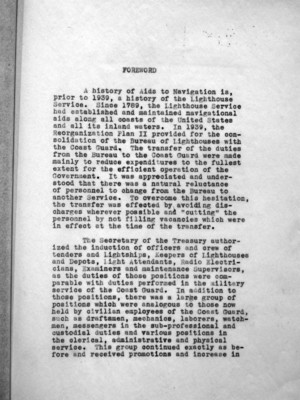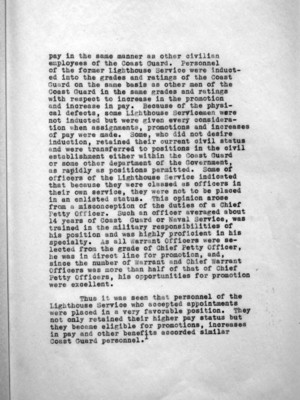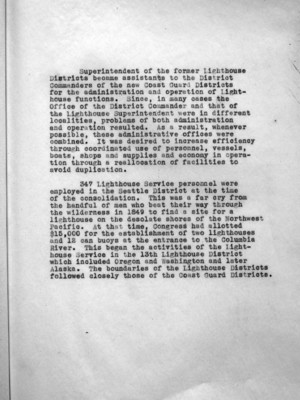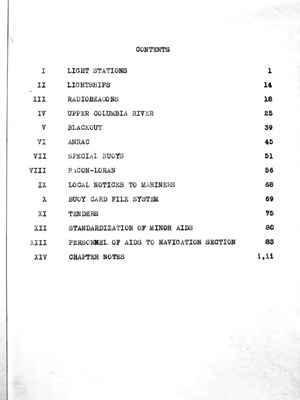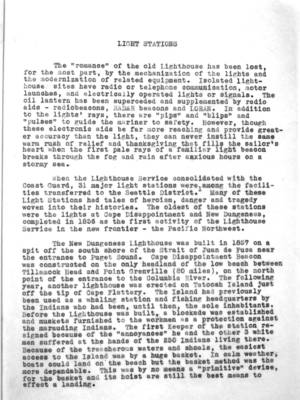Pages
16
FOREWORD
A history of Aids to Navigation is, prior to 1939, a history of the Lighthouse Service. Since 1789, the Lighthouse Service had established and maintained navigational aids along all coasts of the United States and all its inland waters. In 1939, the Reorganization Plan II provided for the consolidation of the Bureau of Lighthouses with the Coast Guard. The transfer of the duties from the Bureau to the Coast Guard were made mainly to reduce expenditures to the fullest extent for the efficient operation of the Government. It was appreciated and understood that there was a natural reluctance of personnel to change from the Bureau to another Service. To overcome this hesitation, the transfer was effected by avoiding discharges wherever possible and "cutting" the personnel by not filling vacancies which were in effect at the time of the transfer.
The Secretary of the Treasury authorized the induction of officers and crew of tenders and Lightships, Keepers of Lighthouses and Depots, Light Attendants, Radio Electricians, Examiners and Maintenance Supervisors, as the duties of those positions were comparable with duties performed in the military service of the Coast Guard. In addition to those positions, there was a large group of positions which were analogous to those now held by civilian employees of the Coast Guard, such as draftsmen, mechanics, laborers, watchmen, messengers in the sub-professional and custodial duties and various positions in the clerical, administrative and physical service. This group continued exactly as before and received promotions and increase in
17
pay in the same manner as other civilian employees of the Coast Guard. Personnel of the former Lighthouse Service were inducted into the grades and ratings of the Coast Guard on the same basis as other men of the Coast Guard in the same grades and ratings with respect to increase in the promotion and increase in pay. Because of the physical defects, some Lighthouse Servicemen were not inducted but were given every consideration when assignments, promotions and increases of pay were made. Some, who did not desire induction, retained their current civil status and were transferred to positions in the civil establishment either within the Coast Guard or some other department of the Government, as rapidly as positions permitted. Some of officers of the Lighthouse Service indicated that because they were classed as officers in their own service, they were not to be placed in an enlisted status. This opinion arose from a misconception of the duties of a Chief Petty Officer. Such an officer averaged about 14 years of Coast Guard or Naval Service, was trained in the military responsibilities of his position and was highly proficient in his specialty. As all Warrant Officers were selected from the grade of Chief Petty Officer, he was in direct line for promotion, and, since the number of Warrant and Chief Warrant Officers was more than half of that of Chief Petty Officers, his opportunities for promotion were excellent.
Thus it was seen that personnel of the Lighthouse Service who accepted appointments were placed in a very favorable position. They not only retained their higher pay status but they became eligible for promotions, increases in pay and other benefits accorded similar Coast Guard personnel.
18
Superintendent of the former Lighthouse Districts became assistants to the District Commanders of the new Coast Guard Districts for the administration and operation of Lighthouse functions. Since, in many cases the Office of the District Commander and that of the Lighthouse Superintendent were in different localities, problems of both administration and operation resulted. As a result, whenever possible, these administrative offices were combined. It was desired to increase efficiency through coordinated use of personnel, vessels, boats, shops and supplies and economy in operation through a reallocation of facilities to avoid duplication.
327 Lighthouse Service personnel were employed in the Seattle District at the time of the consolidation. This was a far cry from the handful of men who beat their way through the wilderness in 1849 to find a site for a lighthouse on the desolate shores of the Northwest Pacific. At that time, Congress had allotted $15,000 for the establishment of two lighthouses and 12 can buoys at the entrance to the Columbia River. This began the activities of the Lighthouse Service in the 13th Lighthouse District which included Oregon and Washington and later Alaska. The boundaries of the Lighthouse Districts followed closely those of the Coast Guard Districts.
19
CONTENTS
I LIGHT STATIONS 1 II LIGHTSHIPS 14 III RADIOBEACONS 18 IV UPPER COLUMBIA RIVER 25 V BLACKOUT 39 VI ANRAC 45 VII SPECIAL BUOYS 51 VIII RACON-LORAN 56 IX LOCAL NOTICES TO MARINERS 68 X BUOY CARD FILE SYSTEM 69 XI TENDERS 75 XII STANDARDIZATION OF MINOR AIDS 80 XIII PERSONNEL OF AIDS TO NAVIGATION SECTION 83 XIV CHAPTER NOTES 1,11
20
LIGHT STATIONS
The "romance" of the old Lighthouse has been lost, for the most part, by the mechanization of the lights and the modernization of related equipment. Isolated lighthouse sites have radio or telephone communication, motor launches, and electrically operated lights or signals. The oil lantern has been superceded and supplemented by radio aids - raidobeacons, RADAR beacons and LORAN. In addition to the lights' rays, there are "pips" and "blips" and "pulses" to guide the mariner to safety. However, though these electronic aids be far more reaching and provide greater accuracy than the light, they can never instill the same warm rush of relief and thanksgiving that fills the sailor's heart when the first pale rays of a familiar light beacon breaks through the fog and rain after anxious hours on a stormy sea.
When the Lighthouse Service consolidated with the Coast Guard, 31 major light stations were among the facilities transferred to the Seattle District.¹ Many of these Light Stations had tales of heroism, danger and tragedy woven into their histories. The oldest of these stations were the lights at Cape Disappointment and New Dungeness, completed in 1856 as the first activity of the Lighthouse Service in the new frontier - the Pacific Northwest.
The New Dungeness Lighthouse was built in 1857 on a spit off the south shore of the Strait of Juan de Fuca near the entrance to Puget Sound. Cape Disappointment Beacon was constructed on the only headland of the low beach between Tillamook Head and Point Grenville (80 miles), on the north point of the entrance to the Columbia River. The following year, another lighthouse was erected on Tatoosh Island just off the tip of Cape Flattery. The Island had previously been used as a whaling station and fishing headquarters by the Indians who had been, until then, the sole inhabitants. Before the Lighthouse was built, a blockade was established and muskets furnished to the workmen as protection against marauding Indians. The first Keeper of the station resigned because of the "annoyances" he and the other 3 white men suffered at the hands of the 250 Indians living there. Because of the treacherous waters and shoals, the easiest access to the Island was by a huge basket. In calm weather, boats could land on the beach but the basket method was the more dependable. This was by no means a "primitive" devise, for the basket and its hoist are still the best means to effect a landing.
